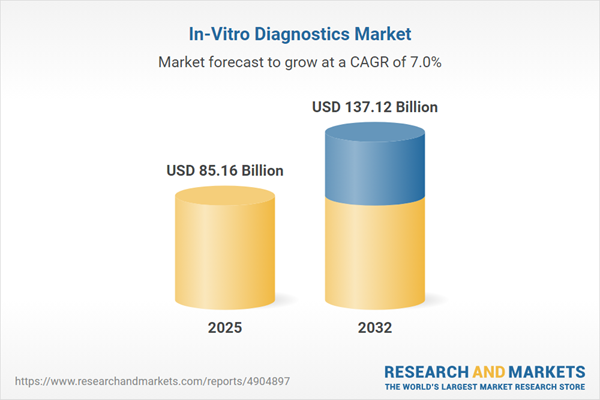Speak directly to the analyst to clarify any post sales queries you may have.
The in-vitro diagnostics market is undergoing significant evolution as the healthcare sector prioritizes early disease detection, efficiency, and patient-centered approaches. Strategic innovation across technology and operations is shaping new opportunities for senior decision-makers navigating this complex landscape.
Market Snapshot: In-Vitro Diagnostics Market Growth Trajectory
The In-Vitro Diagnostics Market grew from USD 79.99 billion in 2024 to USD 85.16 billion in 2025. It is expected to continue growing at a CAGR of 6.96%, reaching USD 137.12 billion by 2032. Driven by an aging population, rising chronic disease rates, and rapid digitalization, the market is experiencing robust expansion. Widespread adoption of advanced automation, development of novel biomarkers, and growing demand for decentralized diagnostic solutions further solidify its growth outlook. Regulatory adaptability and global healthcare reforms are catalyzing new models of diagnostics accessibility, while regionalization strategies are becoming essential for managing procurement risk and operational continuity.
Scope & Segmentation
The report offers a comprehensive evaluation of the in-vitro diagnostics market, providing actionable insight into product, application, and end-user trends, as well as regional dynamics and key innovation drivers.
- Product Type: Instruments, Reagents & Kits, Software & Services, including calibration services, consultancy services, diagnostic software, and maintenance services
- Test Type: Clinical Chemistry (blood analysis, electrolyte panel, liver panel, thyroid function panel, urine analysis), Hematology, Immunoassays, Microbiology, Molecular Diagnostics
- Specimen: Blood, Serum & Plasma, Saliva, Tissue Samples, Urine
- Application: Autoimmune Diseases, Cancer Detection, Cardiac Monitoring, Diabetes Management, Genetic Testing, Infectious Disease Testing
- End User: Academic & Research Centers, Diagnostic Laboratories, Hospitals, Point-Of-Care Testing Centers
- Regions: Americas (United States, Canada, Mexico, Brazil, Argentina, Chile, Colombia, Peru), Europe (United Kingdom, Germany, France, Russia, Italy, Spain, Netherlands, Sweden, Poland, Switzerland), Middle East (United Arab Emirates, Saudi Arabia, Qatar, Turkey, Israel), Africa (South Africa, Nigeria, Egypt, Kenya), Asia-Pacific (China, India, Japan, Australia, South Korea, Indonesia, Thailand, Malaysia, Singapore, Taiwan)
- Technology Use: Integration of artificial intelligence, machine learning, automation systems, cloud platforms, high-throughput sequencing, and precision biomarkers across workflow applications
- Companies Analyzed: Key players include Agappe Diagnostics Ltd., Becton, Dickinson and Company, Siemens AG, Thermo Fisher Scientific, Inc., Sysmex Corporation, Grifols S.A., and others across the global value chain
Key Takeaways for Decision-Makers
- Investment in digital health platforms and data integration is enabling scalable diagnostic workflows and enhancing clinical decision support.
- Rising demand for decentralized and point-of-care solutions is reshaping how diagnostics are delivered and improving accessibility in remote and community settings.
- Collaborations between diagnostic developers, contract manufacturers, and clinical research institutions are accelerating the translation of innovation into routine practice.
- Strategic regionalization and local manufacturing partnerships are strengthening supply resilience, mitigating trade and tariff-related disruptions.
- Workforce development and training in automation, data interpretation, and compliance are vital for maintaining operational excellence as technology complexity increases.
- Corporate strategies increasingly focus on bolt-on acquisitions and targeted R&D investments to adapt portfolios to rapidly shifting market trends and local regulatory requirements.
Tariff Impact Analysis
New U.S. tariffs introduced in 2025 have raised costs for high-value instruments and critical reagents, driving manufacturers to reassess sourcing and explore regional agreements. This shift is accelerating investments in North American manufacturing and stimulating closer partnerships with local contract organizations to safeguard supply chains and control long-term operational impact. Procurement strategies are adapting to maintain pricing flexibility and ensure consistent market availability, influencing competitive positioning across the sector.
Methodology & Data Sources
Research is based on a multi-stage approach, including structured primary interviews with industry leaders, supplemented by secondary analysis of peer-reviewed studies, regulatory filings, and industry reports. Rigorous data triangulation and expert validation processes ensure conclusions are actionable, robust, and aligned with client decision-making needs.
Why This Report Matters
- Supports senior leaders in formulating strategies that align innovation, compliance, and market expansion objectives across multiple regions.
- Enables risk mitigation through actionable insights on supply resilience, tariff effects, and evolving procurement models.
- Equips organizations with detailed segmentation and emerging technology trends to optimize resource allocation and R&D focus for sustainable growth.
Conclusion
The in-vitro diagnostics industry is transforming in response to new technological, regulatory, and operational demands. Market participants leveraging digital integration, regional adaptability, and collaborative models are positioned for long-term advantage as the landscape evolves.
Additional Product Information:
- Purchase of this report includes 1 year online access with quarterly updates.
- This report can be updated on request. Please contact our Customer Experience team using the Ask a Question widget on our website.
Table of Contents
3. Executive Summary
4. Market Overview
7. Cumulative Impact of Artificial Intelligence 2025
Companies Mentioned
The companies profiled in this In-Vitro Diagnostics market report include:- Agappe Diagnostics Ltd.
- ARKRAY Inc.
- Asahi Kasei Pharma Corporation
- Becton, Dickinson and Company
- Edan Instruments, Inc.
- Grifols S.A.
- HiMedia Laboratories Pvt. Ltd.
- Hitachi Ltd.
- Hologic, Inc.
- J Mitra & Co. Pvt. Ltd.
- KAINOS Laboratories, Inc.
- Kyowa Medex Co., Ltd.
- Meril Diagnostics Pvt. Ltd.
- Mindray Bio-Medical Electronics Co., Ltd.
- Nihon Kohden Corporation
- PerkinElmer, Inc.
- Sekisui Medical Co., Ltd.
- Shanghai Kehua Bio-engineering Co., Ltd.
- Siemens AG
- Sino Biopharmaceutical Limited
- Sysmex Corporation
- Thermo Fisher Scientific, Inc.
- Tosoh Corporation
- Transasia Bio-Medicals Ltd.
- Zhejiang Orient Gene Biotech Co
Table Information
| Report Attribute | Details |
|---|---|
| No. of Pages | 186 |
| Published | November 2025 |
| Forecast Period | 2025 - 2032 |
| Estimated Market Value ( USD | $ 85.16 Billion |
| Forecasted Market Value ( USD | $ 137.12 Billion |
| Compound Annual Growth Rate | 6.9% |
| Regions Covered | Global |
| No. of Companies Mentioned | 26 |









